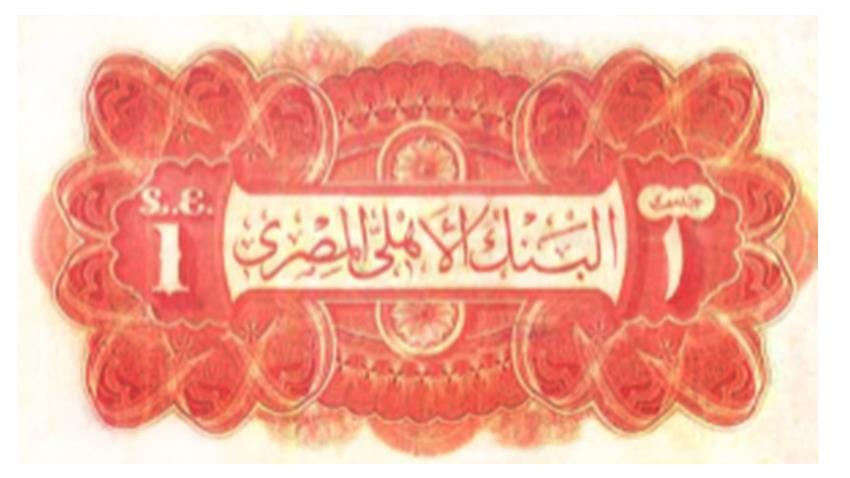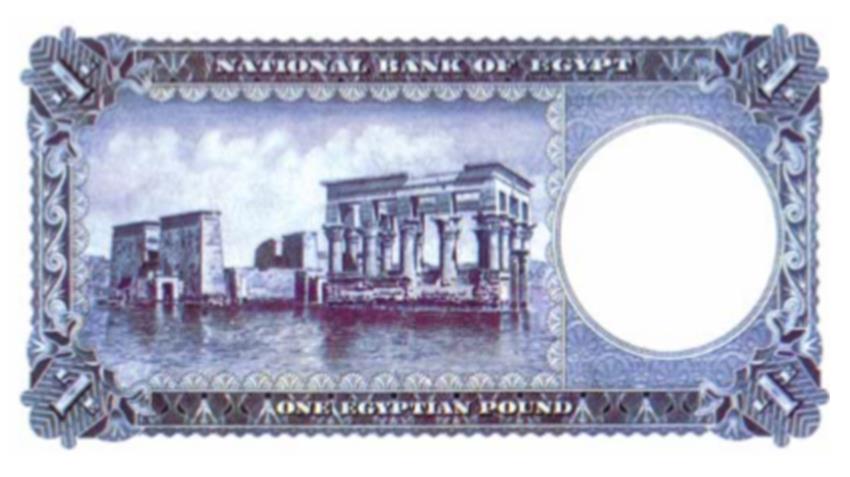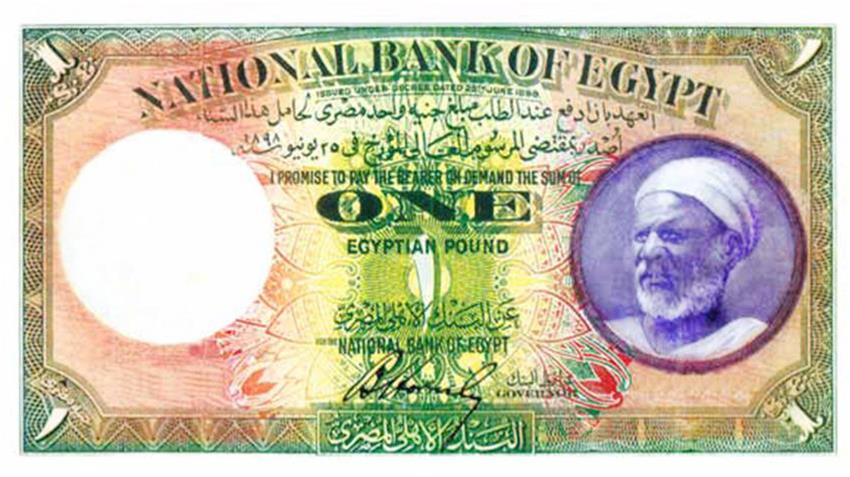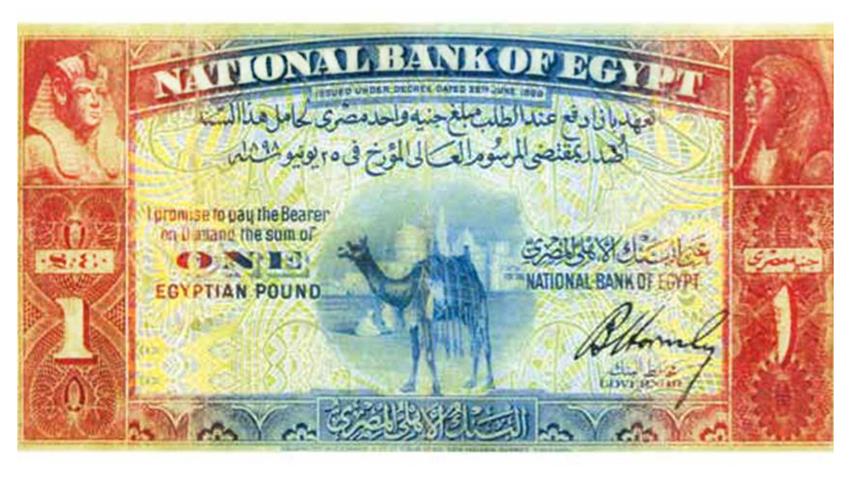
The official currency of Egypt
The first pound was issued in Egypt in 1836, when it was put into circulation in the Egyptian markets and replaced the official currency in circulation at the time, which was gold and silver .
The Egyptian pound is the oldest currency in the region, and it was issued with a great value that amounted to what was equivalent at the time to the value of 20 thousand pounds at the present time. It was called the pound because Egypt was under British occupation, and the currency of England was the pound, which was later called the pound sterling .
The pound was divided into piastres, equal to 100 piastres, and the penny was divided into ten millimeters, and its singular is a penny. During the reign of the governor Muhammad Saeed Pasha, the ten piastres were created, and the Egyptians called it “Al-Barizah” in relation to it being struck and stamped in Paris, the capital of France.
On April 3 of the year 1899, the National Bank of Egypt issued banknotes for the first time, and the paper pound was issued, and its value was equal to 7.4 grams of gold, and this standard was used between 1885 and the outbreak of World War I in 1914, when the Egyptian pound was linked to the pound sterling and the pound The pound sterling equals 0.9 Egyptian pounds .
The printing of the pound developed throughout the twentieth century, as it was printed abroad, and in 1968 it was established the bank Central Egyptian Dara to print criticism And it began in Print categories different from currencies leafy category pound And the ten pennies And the 25 piasters and others in the first from December from 1968 as _ got up the bank also prints some currencies Arab countries for the benefit of its central banks .
During the reign of King Ahmed Fouad, the Egyptians noticed the presence of a picture of a servant named Idris on the pound, and when they searched for the reason, they discovered that there was an exciting story behind this.
The Egyptian pound is the oldest currency in the region, and it was issued with a great value that amounted to what was equivalent at the time to the value of 20 thousand pounds at the present time. It was called the pound because Egypt was under British occupation, and the currency of England was the pound, which was later called the pound sterling .
The pound was divided into piastres, equal to 100 piastres, and the penny was divided into ten millimeters, and its singular is a penny. During the reign of the governor Muhammad Saeed Pasha, the ten piastres were created, and the Egyptians called it “Al-Barizah” in relation to it being struck and stamped in Paris, the capital of France.
On April 3 of the year 1899, the National Bank of Egypt issued banknotes for the first time, and the paper pound was issued, and its value was equal to 7.4 grams of gold, and this standard was used between 1885 and the outbreak of World War I in 1914, when the Egyptian pound was linked to the pound sterling and the pound The pound sterling equals 0.9 Egyptian pounds .
The printing of the pound developed throughout the twentieth century, as it was printed abroad, and in 1968 it was established the bank Central Egyptian Dara to print criticism And it began in Print categories different from currencies leafy category pound And the ten pennies And the 25 piasters and others in the first from December from 1968 as _ got up the bank also prints some currencies Arab countries for the benefit of its central banks .
During the reign of King Ahmed Fouad, the Egyptians noticed the presence of a picture of a servant named Idris on the pound, and when they searched for the reason, they discovered that there was an exciting story behind this.


Ahmed Fouad became king over Egypt, so the prince smiled and told him that it was difficult, because his brother, Sultan Hussein, has a crown prince, and he is his son, Prince Kamal al-Din Hussein, and he is the one who will take over after him, but the servant assured him that he had seen him in the dream sitting on the throne of Egypt and in Abdeen Palace The prince laughed, and told him jokingly that if he ruled Egypt, he would put his picture of Idris on the pound .
Indeed, Idris’s dream came true, and Prince Kamal al-Din Hussein abdicated the throne of Egypt, and the sultan his father died. Suddenly, Prince Fuad found himself the sultan of Egypt, so he went to the palace to find Idris sitting praying, so he sat next to him until he finished his prayer, then he said to him, “Your dream has come true and you have become a sultan over Egypt, and your image will be on The first pound issued by my government.” King Fuad I fulfilled his promise and issued Idris Al-Falah’s pound on July 8, 1928 .
Egyptian Arts on Paper Currency Book” by Dr. Ashraf Reda reveals the designs, creations and innovations that accompanied Egypt’s official currency and says that Egypt remained without a specific monetary unit until 1834, when Muhammad Ali issued a firman ordering the issuance of an Egyptian currency based on the two-metal system gold and silver, each of which has strength Unlimited discharge. The unit of money was a gold piece of 20 piasters, called the golden riyal, and a piece of silver of 20 piasters, also called the silver riyal, until the first Egyptian currencies were issued in 1836 .
In 1898, the first commercial bank to practice banking operations in Egypt was issued, which is the National Bank, and the government granted it the privilege of issuing cash for a period of 50 years. Between gold and sterling pounds, in addition to Egyptian banknotes exchangeable for gold . In 1930, for the first time, the watermark was used on banknotes to protect them from forgery, and in 1944 the image of kings appeared on the coins, where a picture of King Farouk of Egypt appeared on the pound, along with some archaeological images such as the Mosque of Muhammad Ali, and on other currencies such as the 25 piastres category .
And the 50 piasters And the five pennies And the ten pennies Developed picture bosses And kings Egypt ex like the king blueberry ankh Amon the queen Nefertiti And yet revolution July situation on coins the ten pennies photos for classes the people like soldier, and the farmer, An Egyptian worker and woman and her Sudanese sister are symbols of the unity of the Nile Valley .
Indeed, Idris’s dream came true, and Prince Kamal al-Din Hussein abdicated the throne of Egypt, and the sultan his father died. Suddenly, Prince Fuad found himself the sultan of Egypt, so he went to the palace to find Idris sitting praying, so he sat next to him until he finished his prayer, then he said to him, “Your dream has come true and you have become a sultan over Egypt, and your image will be on The first pound issued by my government.” King Fuad I fulfilled his promise and issued Idris Al-Falah’s pound on July 8, 1928 .
Egyptian Arts on Paper Currency Book” by Dr. Ashraf Reda reveals the designs, creations and innovations that accompanied Egypt’s official currency and says that Egypt remained without a specific monetary unit until 1834, when Muhammad Ali issued a firman ordering the issuance of an Egyptian currency based on the two-metal system gold and silver, each of which has strength Unlimited discharge. The unit of money was a gold piece of 20 piasters, called the golden riyal, and a piece of silver of 20 piasters, also called the silver riyal, until the first Egyptian currencies were issued in 1836 .
In 1898, the first commercial bank to practice banking operations in Egypt was issued, which is the National Bank, and the government granted it the privilege of issuing cash for a period of 50 years. Between gold and sterling pounds, in addition to Egyptian banknotes exchangeable for gold . In 1930, for the first time, the watermark was used on banknotes to protect them from forgery, and in 1944 the image of kings appeared on the coins, where a picture of King Farouk of Egypt appeared on the pound, along with some archaeological images such as the Mosque of Muhammad Ali, and on other currencies such as the 25 piastres category .
And the 50 piasters And the five pennies And the ten pennies Developed picture bosses And kings Egypt ex like the king blueberry ankh Amon the queen Nefertiti And yet revolution July situation on coins the ten pennies photos for classes the people like soldier, and the farmer, An Egyptian worker and woman and her Sudanese sister are symbols of the unity of the Nile Valley .


The year 1993 witnessed the issuance of a fifty-pound note for the first time in the history of the Central Bank, as it was printed with a watermark of the image of Tutankhamun, and by the end of 1994 a new hundred-pound note was issued in a design bearing the image of the Sultan Hassan Mosque with backgrounds and a decorative frame of Arab arts with a head in the middle. Sphinx in shades of red and green, and the two papers carried about 20 insurance elements .
In October of the year 2003, the Central Bank issued a new banknote in the denomination of ten pounds, with a new modern design, with more elements of insurance and protection, with a picture of the Al-Rifai Mosque, and the back of the note bore the image of King Khafra. And she is the daughter of Sultan Al-Nasser Muhammad. An insurance element was used in the paper for the first time, which is a hologram tape that reflects the colors of the spectrum, as well as a magnetic tape that is recognized by the bank’s counting machines with the number 200 printed on it .
In 2005, Egypt introduced the metallic pound instead of the paper pound, and dealing in the paper pound was prohibited in the Egyptian market until a decision was issued by Tariq Amer, the current governor of the Central Bank, to print the pound paper currency again .
Taha , an economist, explains to Al-Arabiya.net the stages of development and the value of the Egyptian pound, and says that the Egyptian pound had a great value during the era of Muhammad Ali until the 1952 revolution for several reasons, including that Egypt was a productive country that exported the finest types of cotton .
In October of the year 2003, the Central Bank issued a new banknote in the denomination of ten pounds, with a new modern design, with more elements of insurance and protection, with a picture of the Al-Rifai Mosque, and the back of the note bore the image of King Khafra. And she is the daughter of Sultan Al-Nasser Muhammad. An insurance element was used in the paper for the first time, which is a hologram tape that reflects the colors of the spectrum, as well as a magnetic tape that is recognized by the bank’s counting machines with the number 200 printed on it .
In 2005, Egypt introduced the metallic pound instead of the paper pound, and dealing in the paper pound was prohibited in the Egyptian market until a decision was issued by Tariq Amer, the current governor of the Central Bank, to print the pound paper currency again .
Taha , an economist, explains to Al-Arabiya.net the stages of development and the value of the Egyptian pound, and says that the Egyptian pound had a great value during the era of Muhammad Ali until the 1952 revolution for several reasons, including that Egypt was a productive country that exported the finest types of cotton .


In 1960, the law establishing the Central Bank of Egypt was issued, as it undertook the issuance of banknotes. On October 3, 1962, the first paper currency bearing the image of the Republic Eagle was issued as a watermark on the ten-pound denomination, and in 1979 the pound was issued in a smaller size, with the image of Sultan Qaytbay Mosque with a floor of Arabic motifs, as well as various drawings of the pound and a chest with antique decorations and inscriptions .
Foodstuffs and grains for Britain, and Britain at that time was the first country in the world economically and militarily, so the value of the Egyptian pound was strong. Indeed, Britain, as a result of the strength of the Egyptian currency, linked it to its currency, in addition to that, as a result of Muhammad Ali establishing a naval fleet and Khedive Ismail establishing the Suez Canal This led to the arrival of Egyptian exports to the whole world, and Egypt was exporting all its products through its fleet and through the Suez Canal to the powerful and rich European countries in the world, so the demand for the Egyptian pound was great and its value and strength increased and was linked to gold, so its value increased more and more, as the pound was based on gold reserves In addition to the increase in Egyptian exports, which led to an increase in demand for it .
The economist adds that economists in the world confirmed that the Egyptian Stock Exchange was ranked fourth in the world, and one of the causes of the global financial crisis in 1929 was the collapse of the cotton stock market in Egypt, as Egypt had 3 stock exchanges at that time, stressing that Egypt was lending to the United States of America After World War II, it even contributed to the payment of large sums of money in the Marshall Plan for the advancement of countries that were still in the stage of recovery from the effects of the World War .
And he says: What happened after that was that Egypt replaced the pound’s link with gold reserves and made it linked to the dollar, which emerged strongly as did other economic powers other than Britain such as Germany, America, France, Japan and China, and at that time and from 1956 to 1973 Egypt entered several major wars Its reserves of gold decreased, exports decreased, and it turned from a producing country to a consuming country, so the demand for the dollar increased as it is a global currency, and the demand for the pound decreased, so its value began to decrease gradually, in addition to the suspension of the Suez Canal after the war and the diminishing of resources, so the import increased at the expense of manufacturing and local production .
Dr. Abd al-Rahman Taha indicates that Sadat, after the end of the war, tried to disengage and get rid of these problems, so he lifted subsidies on goods, in order to liberalize prices and reduce imports, but he opened the door to openness, so imports increased more and more, and every time the demand for the dollar increased, and with it the shortage of exports increased, so the value decreased. The pound This policy continued until now, which led to a significant devaluation of the Egyptian pound against the dollar .
He says that the recent decisions taken by the Egyptian government and President Abdel Fattah El-Sisi are strong and capable of restoring the Egyptian currency to its true strength and value through several basic pillars :
The economist adds that economists in the world confirmed that the Egyptian Stock Exchange was ranked fourth in the world, and one of the causes of the global financial crisis in 1929 was the collapse of the cotton stock market in Egypt, as Egypt had 3 stock exchanges at that time, stressing that Egypt was lending to the United States of America After World War II, it even contributed to the payment of large sums of money in the Marshall Plan for the advancement of countries that were still in the stage of recovery from the effects of the World War .
And he says: What happened after that was that Egypt replaced the pound’s link with gold reserves and made it linked to the dollar, which emerged strongly as did other economic powers other than Britain such as Germany, America, France, Japan and China, and at that time and from 1956 to 1973 Egypt entered several major wars Its reserves of gold decreased, exports decreased, and it turned from a producing country to a consuming country, so the demand for the dollar increased as it is a global currency, and the demand for the pound decreased, so its value began to decrease gradually, in addition to the suspension of the Suez Canal after the war and the diminishing of resources, so the import increased at the expense of manufacturing and local production .
Dr. Abd al-Rahman Taha indicates that Sadat, after the end of the war, tried to disengage and get rid of these problems, so he lifted subsidies on goods, in order to liberalize prices and reduce imports, but he opened the door to openness, so imports increased more and more, and every time the demand for the dollar increased, and with it the shortage of exports increased, so the value decreased. The pound This policy continued until now, which led to a significant devaluation of the Egyptian pound against the dollar .
He says that the recent decisions taken by the Egyptian government and President Abdel Fattah El-Sisi are strong and capable of restoring the Egyptian currency to its true strength and value through several basic pillars :


First: President El-Sisi took 17 bold decisions in his capacity as head of the Supreme Council for Investment. These decisions would increase local manufacturing, support and diversify exports, and transform Egypt into a productive country as it was in the past, which reduces dependence on imports, decreases demand for the dollar, and lowers its value against the pound .
Second: Liberalizing the exchange rate, which will eliminate the black market, open the door to attracting foreign investments, provide real job opportunities, and create a productive environment that reduces Egypt’s dependence on its needs from abroad, encourages tourism, and provides Egypt with a large surplus of hard currency .
Third: Canceling subsidies on fuel, fuel, and other goods and services, and this will reduce the burden on the balance of payments and thus facilitate the use of the domestic product, most of which was allocated to subsidies for spending in service sectors such as health, education, and infrastructure, all of which ultimately achieve two direct goals, which are investment in the Egyptian person through health and education. Being the first factor in achieving development, and the second is providing infrastructure and creating attractive elements for investment capable of creating a strong country that enters the stage of economic progress .
Fourth: Entering Egypt into the era of energy, which has been achieved with new discoveries in gas and oil, all of which will show their effects from next year and the year after until Egypt reaches energy self-sufficiency in 2021 and enters the club of oil-producing countries .
Fifth: All of the foregoing reduces the demand for the dollar and increases dependence on the pound, so that it returns to its strength and becomes one of the internationally required currencies, and thus it can stand in front of the dollar and the basket of other currencies .
Second: Liberalizing the exchange rate, which will eliminate the black market, open the door to attracting foreign investments, provide real job opportunities, and create a productive environment that reduces Egypt’s dependence on its needs from abroad, encourages tourism, and provides Egypt with a large surplus of hard currency .
Third: Canceling subsidies on fuel, fuel, and other goods and services, and this will reduce the burden on the balance of payments and thus facilitate the use of the domestic product, most of which was allocated to subsidies for spending in service sectors such as health, education, and infrastructure, all of which ultimately achieve two direct goals, which are investment in the Egyptian person through health and education. Being the first factor in achieving development, and the second is providing infrastructure and creating attractive elements for investment capable of creating a strong country that enters the stage of economic progress .
Fourth: Entering Egypt into the era of energy, which has been achieved with new discoveries in gas and oil, all of which will show their effects from next year and the year after until Egypt reaches energy self-sufficiency in 2021 and enters the club of oil-producing countries .
Fifth: All of the foregoing reduces the demand for the dollar and increases dependence on the pound, so that it returns to its strength and becomes one of the internationally required currencies, and thus it can stand in front of the dollar and the basket of other currencies .
